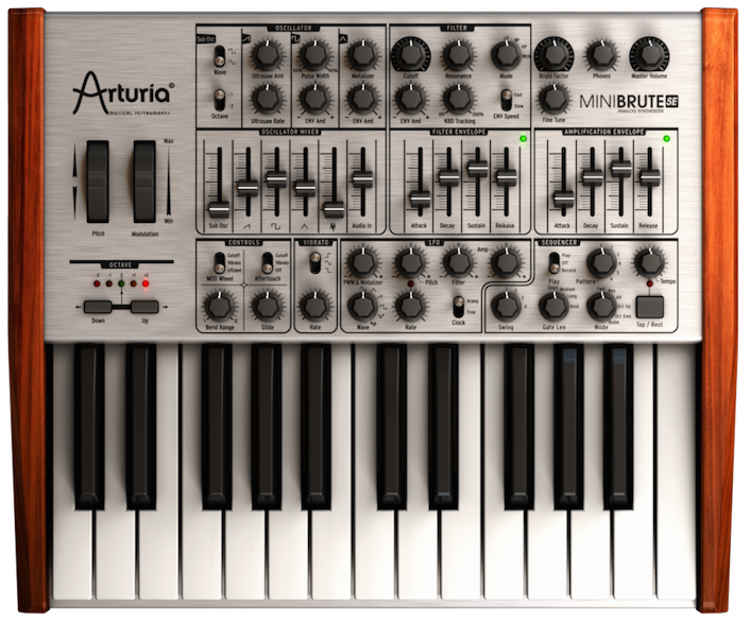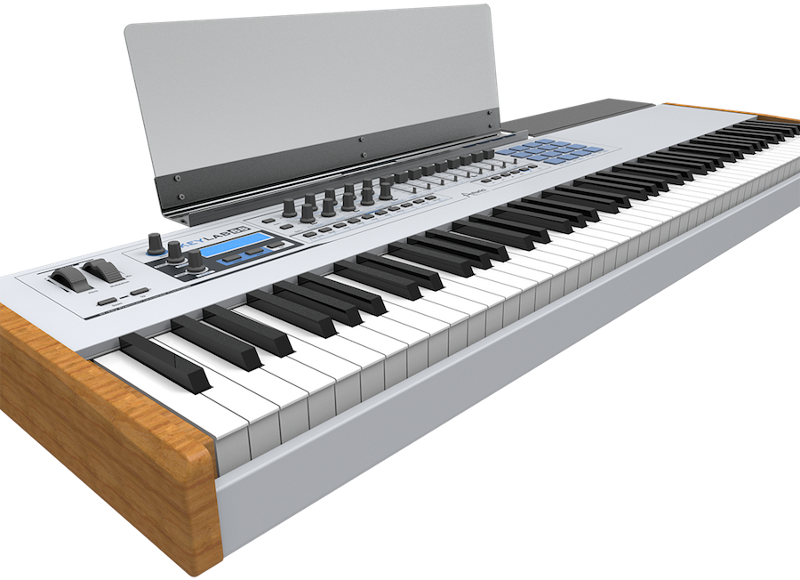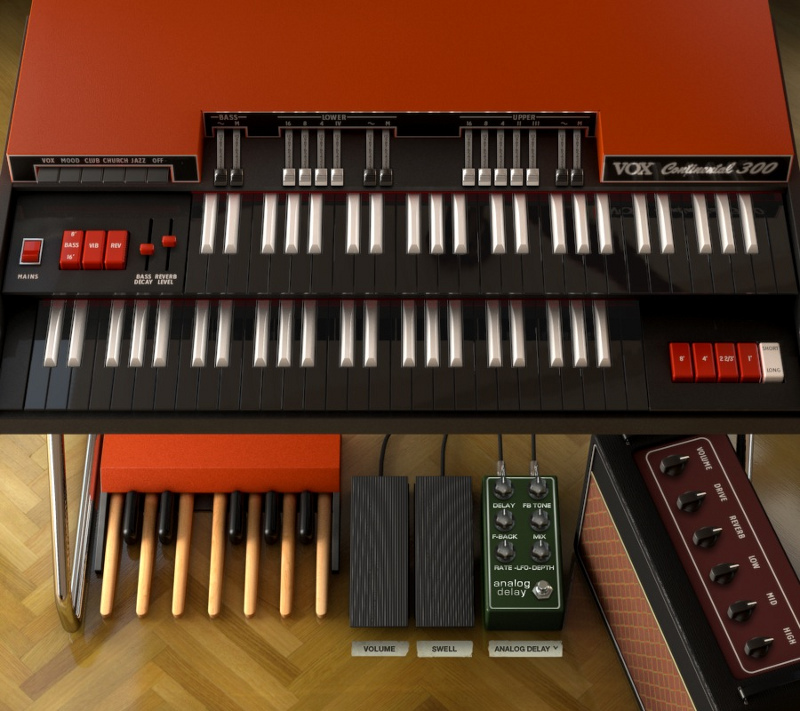 Arturia zeigt auf der Musikmesse eine „Special Edition“ des MiniBrute Mono Synth mit dem Namen MiniBrute SE. Außerdem wird ein 88 Tasten Modell der KeyLab Reihe vorgestellt. Zum guten Schluss gibt es dann auch noch eine Software Emulation der Vox Continental 300 Orgel aus den 60er Jahren des letzten Jahrhunderts welche unter dem Namen „VOX Continental-V“ vertrieben wird. Hier die Presseinfos:
Arturia zeigt auf der Musikmesse eine „Special Edition“ des MiniBrute Mono Synth mit dem Namen MiniBrute SE. Außerdem wird ein 88 Tasten Modell der KeyLab Reihe vorgestellt. Zum guten Schluss gibt es dann auch noch eine Software Emulation der Vox Continental 300 Orgel aus den 60er Jahren des letzten Jahrhunderts welche unter dem Namen „VOX Continental-V“ vertrieben wird. Hier die Presseinfos:
MiniBrute SE:

Although a sturdy and stylish brushed aluminium casing with wooden sides surely make MiniBrute SE stand out from the analogue crowd, skin-deep good looks are not the be and end all here, however, as added functionality runs deeper still. An all-new step SEQUENCER elegantly expands playing options with the MiniBrute SE — six Pattern sequences with up to 64 steps each to create multiple musical phrases, to be precise. Yet it is capable of so much more than simply replaying pre- programmed Pattern sequences ad infinitum. Users can create new musical phrases from existing ones by changing the playback Mode, Gate Len (timing), and Swing settings in realtime from the clearly labelled front panel — perfect for inspiring new musical ideas and creating exciting live performances on the fly.
MiniBrute SE is proof positive that the original MiniBrute was no fly-by-night success story. A pure analogue signal path and attractive features like a multi-wave OSCILLATOR and Sub Osc combined with a huge-sounding Steiner-Parker multimode FILTER (fittingly revised by Nyle Steiner himself) and wide-ranging modulation capabilities confirm that MiniBrute SE continues to innovate while breathing new life into recordings and stage performances. Add fantastic features like Ultrasaw (generating shimmering sawtooth waveforms), Metalizer (adding extreme triangle waveform-induced harmonics), LFO (with sample and hold), and full USB/MIDI/CV connectivity into the musical mix, and what have you got? A killer-sounding, step sequencing-capable synth with looks to die for, that’s what!

 Arturia is proud to launch KeyLab 88 — its top-of-the-range 88-note MIDI keyboard controller and hybrid synthesizer solution — at Musikmesse 2014, March 12-15 in Frankfurt, Germany.
Arturia is proud to launch KeyLab 88 — its top-of-the-range 88-note MIDI keyboard controller and hybrid synthesizer solution — at Musikmesse 2014, March 12-15 in Frankfurt, Germany.Taking its rightful place at the centre of any studio or stage setup where performance is paramount, KeyLab 88’s removable laptop/lead synth stand features a rubber base to prevent slippage during performances — perfect for a spot of speedy soloing on Arturia’s award-winning MiniBrute Analog Synthesizer, maybe? More often than not, precarious placement of laptops is a tricky problem faced by today’s computer-based keyboard performers — not so with KeyLab 88’s aforesaid stand. Screw it on and bring it on! Similarly, its integrated music stand can also accommodate an iPad, so why not also bring along Arturia’s innovative iMini or iSEM iPad soft synths for the musical ride?
Neither standalone synth nor iPad are absolutely necessary, of course. Complementing KeyLab 88’s performance- orientated keyboard is a feature-packed panel positively bristling with controls. A supportive selection of knobs and sliders, 16 backlit pressure-sensitive pads, plus an informative LED screen all add up to enriching the performance experience and aiding speedy software navigation. Needless to say, KeyLab 88 definitely delivers on its promise to provide the immediacy of a hardware synthesizer with the flexibility of a software-based solution since it is entirely preassigned to work with Analog Lab from the get-go. Fashion filter cutoff, reduce resonance, adjust ADSR envelopes, and much more besides — but without the inconvenience of having to always reach for a mouse or trackpad.

Despite being phased out of production in the early-Seventies, the Vox Continental has stood the test of time, too, playing a pivotal part in generating many of the distinctive keyboard sounds supporting later musical genres, including almost everything ever recorded by British Ska revivalists Madness, as well as New Wavers like Elvis Costello and The Attractions and American counterparts Tom Petty and The Heartbreakers. However, Vox organs have become increasingly difficult to acquire due to the high prices that they can command, compounded by the limited supply of working units. Today, VOX Continental-V gives contemporary, computer-based musicians instant access to those same hit-making sounds of yesteryear, and much more besides — and all without breaking the bank!
Like the transcontinental history of the original Vox Continental, the road to creating VOX Continental-V was a long and winding affair. Arturia started its latest software developmental journey in the company of a rare Vox Continental 300 dual-manual model, capturing every nuance of the original right down to key contact timing and background noises — no elbows needed! Next, Arturia acquired a rare Jennings J70 — developer Tom Jennings’ Vox organ forerunner — and added a J70 Mode to the VOX Continental-V voice engine. End users have effectively ended up with two ultra-rare organs for the price of one as a result — with more tones to play with, which musically is a good thing to have!
